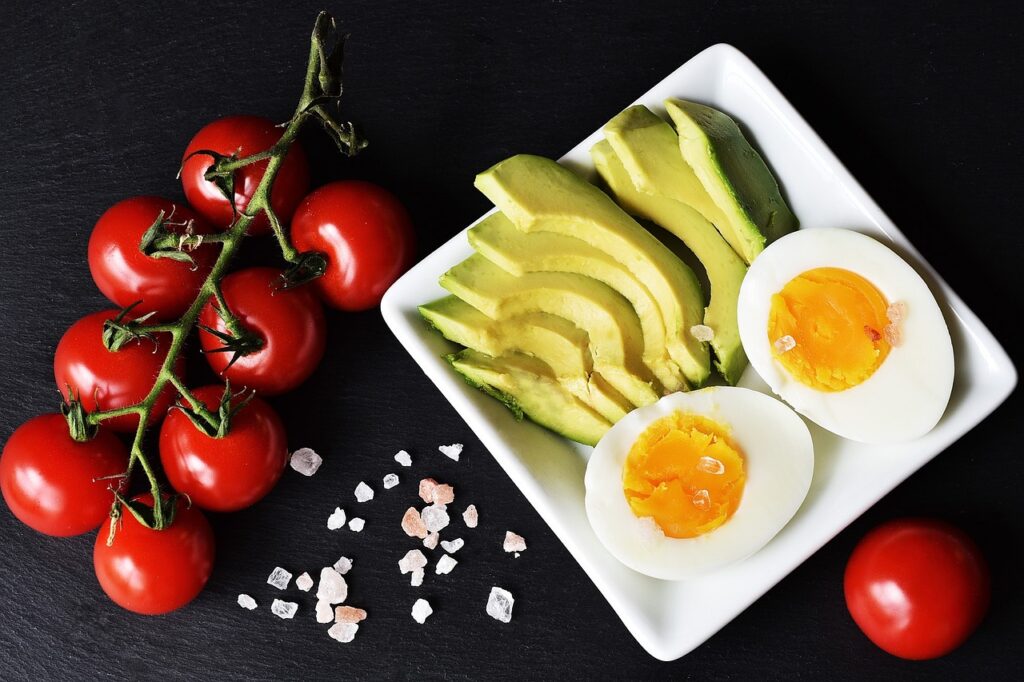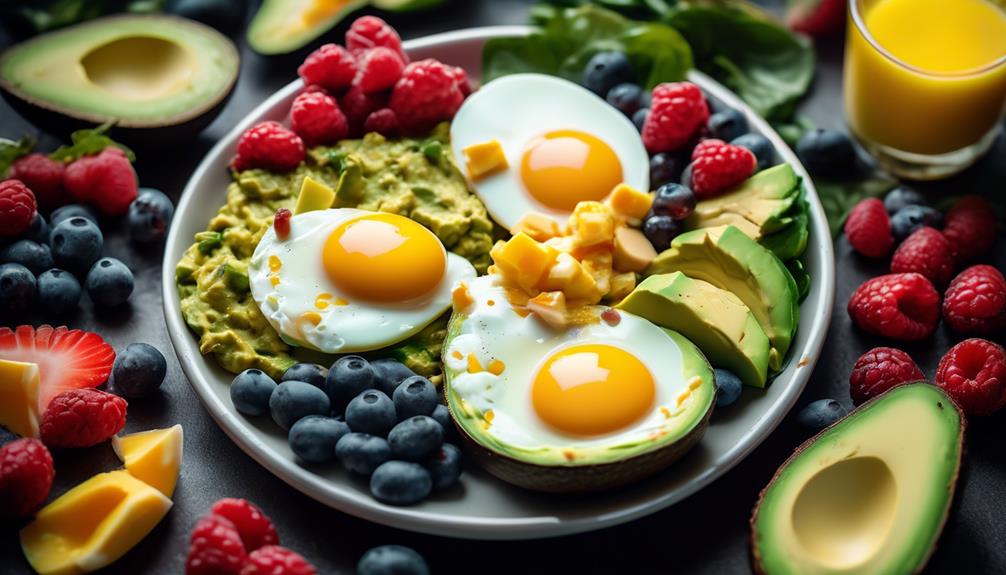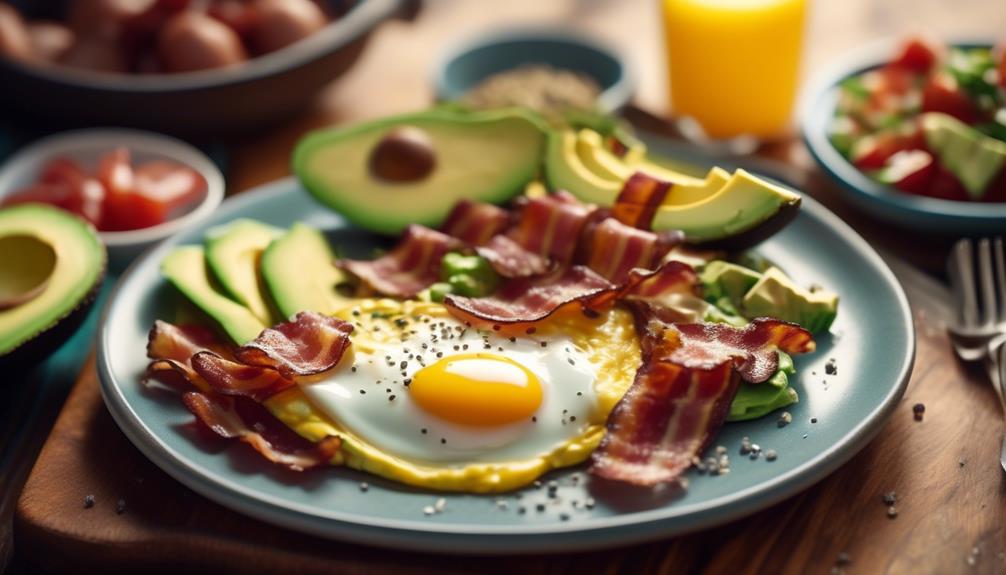Are you tired of the same old high-carb casseroles that leave you feeling sluggish and bloated?
Well, here's an interesting statistic for you: did you know that the average American consumes over 200 grams of carbohydrates per day, which is more than double the recommended amount?
But fear not, because I have a delicious solution for you – a low-carb zucchini and eggplant casserole that not only satisfies your taste buds, but also helps you maintain a healthy lifestyle.
With its layers of tender zucchini and eggplant, flavorful spices, and a low-carb sauce that brings everything together, this casserole is a true winner.
But that's not all, there are also tips for making it ahead of time and storing leftovers for later enjoyment.
So, if you're ready to discover a mouthwatering low-carb recipe that will leave you feeling satisfied and guilt-free, keep reading!
Choosing the Right Vegetables

To ensure your low-carb zucchini and eggplant casserole turns out delicious and nutritious, it's essential to carefully select the right vegetables for this wholesome dish. When it comes to low-carb vegetables, zucchini and eggplant are excellent options. However, if you're looking to add some variety to your casserole, there are alternative vegetable options that can be equally delicious and low in carbs.
One benefit of using low-carb vegetables in your casserole is that they're packed with essential nutrients while being low in calories. Zucchini, for example, is a great source of vitamins A and C, as well as potassium and fiber. Eggplant, on the other hand, is rich in antioxidants and contains important minerals like manganese and copper. Both vegetables also provide a good amount of water, which can help keep you hydrated.
If you're looking for alternative vegetable options, consider adding bell peppers, mushrooms, or cauliflower to your casserole. Bell peppers are low in carbs and high in vitamin C, while mushrooms are a great source of B vitamins and minerals like selenium and copper. Cauliflower is another versatile option that can be used as a low-carb substitute for potatoes or rice.
Preparing the Zucchini and Eggplant
When preparing the zucchini and eggplant for your low-carb casserole, it's important to handle these vegetables with care to ensure optimal texture and flavor. Here are some tips to help you choose the right vegetables and store any leftovers:
- Choosing the right vegetables:
- Select zucchini and eggplant that are firm and shiny, with no soft spots or blemishes. This indicates freshness and ensures that the vegetables will have a good texture when cooked.
- Look for smaller zucchini and eggplant, as they tend to have fewer seeds and a more delicate flavor. They're also easier to slice and cook evenly.
- Storing leftovers:
- If you have any leftover zucchini and eggplant, store them in an airtight container in the refrigerator for up to 3 days.
- To maintain their texture, it's best to store the zucchini and eggplant separately from any sauce or other ingredients. This will prevent them from becoming too soggy.
- When reheating, gently warm them in a skillet or oven to revive their flavors and retain their texture.
Layering the Vegetables in the Casserole Dish

Are you wondering how to layer the vegetables in your low-carb zucchini and eggplant casserole? Layering the vegetables in a casserole dish is an important step in creating a delicious and visually appealing dish. To ensure even cooking and optimal flavor distribution, it's essential to follow proper layering techniques.
When it comes to layering zucchini and eggplant, it's important to slice them into uniform thickness. This helps in ensuring that the vegetables cook evenly and maintain their texture. Aim for a thickness of about ¼ inch for both the zucchini and eggplant slices. If the slices are too thick, they may take longer to cook and result in an unevenly cooked casserole. On the other hand, if the slices are too thin, they may become mushy and lose their shape.
To start layering, begin with a thin layer of tomato sauce or any other sauce of your choice at the bottom of the casserole dish. This will prevent the vegetables from sticking to the dish and add flavor to the dish.
Next, arrange a single layer of zucchini slices on top of the sauce, slightly overlapping them. Sprinkle some salt and pepper to season the zucchini layer.
Repeat the process with a layer of eggplant slices. Continue alternating between the zucchini and eggplant layers until you have used up all the vegetables.
Adding Flavorful Spices and Seasonings
Now that you have properly layered the zucchini and eggplant in your casserole dish, it's time to enhance the flavors by adding a variety of spices and seasonings. By using flavorful spice combinations and incorporating fresh herbs, you can take your low-carb zucchini and eggplant casserole to the next level.
Here are some suggestions to help you create a deliciously seasoned dish:
- Flavorful spice combinations:
- Italian seasoning: This blend typically includes herbs like basil, oregano, thyme, and rosemary, which add a savory and aromatic touch to your casserole.
- Garlic and onion powder: These staples can bring a rich depth of flavor to the dish without overpowering the natural taste of the vegetables.
- Benefits of using fresh herbs:
- Fresh basil: Its sweet and slightly peppery flavor complements the mild taste of zucchini and eggplant perfectly.
- Fresh parsley: Adding a handful of chopped parsley not only adds brightness but also provides a mild earthy flavor that balances the dish.
Using these flavorful spice combinations and fresh herbs won't only enhance the taste of your low-carb zucchini and eggplant casserole but also provide added health benefits and aroma. Experiment with different combinations to find your favorite blend, and enjoy a satisfying and flavorful meal.
Incorporating a Low-Carb Sauce

To add another layer of flavor and moisture to your low-carb zucchini and eggplant casserole, consider incorporating a delicious and low-carb sauce. While traditional sauces may be high in carbohydrates, there are plenty of low-carb sauce substitutions that can elevate your casserole without compromising your dietary goals.
One popular low-carb sauce substitution is using a tomato-based sauce with no added sugar. Look for brands that offer low-carb or sugar-free options. Another option is to make your own sauce using fresh tomatoes, garlic, herbs, and spices. This allows you to control the ingredients and ensure that it remains low in carbs.
If you're looking for a creamier sauce, consider using a combination of Greek yogurt and herbs. The tanginess of the yogurt adds a unique flavor while keeping the carbs low. Alternatively, you can use a low-carb cream sauce made with heavy cream, butter, and seasonings.
For creative sauce pairings, consider using a pesto sauce made with fresh basil, pine nuts, garlic, and olive oil. This adds a vibrant and herbaceous flavor to your casserole. Another option is a lemon butter sauce, which complements the flavors of zucchini and eggplant beautifully.
Selecting the Perfect Cheese
When selecting the perfect cheese for your low-carb zucchini and eggplant casserole, consider the variety of cheese options available. Different cheese varieties can add unique flavors and textures to your dish.
Additionally, it's important to consider the melting properties of the cheese you choose, as certain cheeses melt better than others, resulting in a creamy and delicious casserole.
Cheese Varieties for Casseroles
Consider the flavor profiles and melting capabilities of different cheese varieties when choosing the perfect cheese for your casserole. The right cheese can elevate the taste and texture of your dish, adding a creamy and savory element.
Here are some cheese pairing tips to help you make the best choice:
- Creamy and Mild Cheeses:
- Mozzarella: Known for its excellent melting capabilities, mozzarella adds a gooey texture to your casserole.
- Monterey Jack: This cheese has a mild flavor and melts well, making it a versatile choice for any casserole.
- Sharp and Flavorful Cheeses:
- Cheddar: A classic choice, cheddar brings a bold flavor to your casserole and pairs well with vegetables.
- Gruyere: With its nutty and slightly sweet taste, gruyere adds a sophisticated touch to your dish.
Melting Properties of Cheese
To enhance the taste and texture of your casserole, selecting the perfect cheese requires considering the melting properties and flavor profiles of different cheese varieties. When it comes to melting cheese, not all types are created equal. Some cheeses, like mozzarella and cheddar, melt smoothly and evenly, while others, such as parmesan and gruyere, have a tendency to become stringy.
If you want to achieve a crispy cheese topping, it's important to choose a cheese that melts well and also develops a nice golden crust. Cheeses like Gruyere, fontina, and provolone are great choices for achieving that desirable crispy texture.
Experiment with different cheese combinations to find the perfect balance of melting properties and flavors for your casserole.
Baking the Casserole to Perfection

For optimal results, bake the zucchini and eggplant casserole until it reaches a golden brown color and the vegetables are tender.
Here are a few tips to help you bake your casserole to perfection:
- Toasting breadcrumbs: Before sprinkling breadcrumbs on top of the casserole, take a few extra minutes to toast them. This will add a delicious crunch and enhance the overall flavor of the dish. Simply heat a dry skillet over medium heat, add the breadcrumbs, and stir frequently until they turn golden brown. Be careful not to burn them, as this can give a bitter taste.
- Using different baking dishes: While a traditional casserole dish works well for this recipe, feel free to experiment with different types of baking dishes. Using a cast-iron skillet or a ceramic baking dish can provide a different texture and presentation. Just make sure to adjust the baking time accordingly, as different materials may conduct heat differently.
Allowing the Casserole to Cool Before Serving
After baking the zucchini and eggplant casserole to perfection, the next step is to allow it to cool before serving. Allowing the casserole to cool has several benefits that can enhance your dining experience.
Firstly, cooling allows the flavors to meld together, resulting in a more harmonious taste. As the casserole cools, the ingredients have time to infuse and develop a deeper, more complex flavor profile. Additionally, cooling helps the casserole set and firm up, making it easier to cut and serve without falling apart.
The science behind cooling also plays a role in the taste and texture of the casserole. When the casserole is hot, the flavors can be overpowering, and the texture may be too soft or runny. By allowing it to cool, the flavors become more balanced and the texture becomes more cohesive. Cooling also allows the casserole to reach its optimal serving temperature, ensuring that it isn't too hot to enjoy.
To cool the casserole, you can place it on a wire rack or a heat-resistant surface. This allows air to circulate around the dish, promoting even cooling. Depending on the size and thickness of the casserole, it may take anywhere from 15 to 30 minutes to cool.
Once it has reached a comfortable temperature, you can serve and enjoy the delicious low-carb zucchini and eggplant casserole.
Adding a Garnish for Extra Flair

To elevate the presentation of your Zucchini & Eggplant Casserole, consider adding a garnish for extra flair.
Colorful edible flowers can provide a pop of color and a touch of elegance.
A drizzle of herb-infused oil can add a burst of flavor, while a sprinkle of toasted nuts can add a delightful crunch.
These garnishes not only enhance the visual appeal of your dish but also bring additional taste and texture to every bite.
Colorful Edible Flowers
Looking to add an extra touch of flair to your low-carb Zucchini & Eggplant Casserole? Consider incorporating colorful edible flowers as a garnish.
Not only do edible flowers add a vibrant pop of color to your dish, but they also have numerous health benefits. In addition to their visual appeal, edible flowers are rich in antioxidants and can provide a variety of vitamins and minerals.
Here are some creative ways to incorporate edible flowers into your dishes:
- Use them as a garnish: Sprinkle edible flowers on top of your casserole to create an eye-catching presentation.
- Infuse them in oils or vinegars: Add a unique flavor to your dressings or marinades by infusing them with edible flowers.
- Freeze them in ice cubes: Add a touch of elegance to your beverages by freezing edible flowers in ice cubes and adding them to your drinks.
However, it's important to note that not all flowers are edible, so make sure to do your research and only use flowers that are safe for consumption.
Herb-Infused Oil Drizzle
To elevate the presentation of your low-carb Zucchini & Eggplant Casserole and add an extra touch of flair, consider drizzling it with a herb-infused oil garnish that won't only enhance the flavors but also provide a visually appealing finishing touch.
Herb-infused oils are a great alternative to traditional garnishes as they infuse the dish with aromatic flavors. You can easily make your own herb-infused oil by combining olive oil with herbs like basil, thyme, or rosemary. Not only does this garnish add a burst of flavor, but it also offers numerous health benefits.
Zucchini and eggplant, the star ingredients of the casserole, are both low in calories and high in fiber, vitamins, and minerals. They're also rich in antioxidants that have been linked to various health benefits, including improved digestion and heart health.
Toasted Nut Sprinkle
Consider adding a delightful finishing touch to your low-carb Zucchini & Eggplant Casserole with a sprinkling of toasted nuts for an extra burst of flavor and flair. Not only do toasted nuts add a satisfying crunch to your dish, but they also offer a range of health benefits.
If you're looking for alternatives to traditional toasted nuts, here are two options to consider:
- Toasted Seeds: Pumpkin seeds, sunflower seeds, or sesame seeds can be toasted to perfection and used as a garnish. They provide a similar texture and nutty flavor, making them a great alternative for those with nut allergies.
- Toasted Coconut Flakes: If you're looking for a sweeter twist, try toasting coconut flakes and sprinkling them over your casserole. The toasty, tropical flavor pairs well with the savory elements of the dish.
Incorporating toasted nuts or alternatives into your low-carb Zucchini & Eggplant Casserole not only adds an enjoyable texture but also introduces a variety of nutrients. Nuts are rich in heart-healthy fats, protein, and fiber, making them a nutritious addition to any meal. Additionally, they provide essential vitamins and minerals such as vitamin E, magnesium, and potassium.
Serving Suggestions for a Complete Meal

For a well-rounded meal, pair this delicious low-carb zucchini and eggplant casserole with a side of fresh salad or roasted chicken.
When it comes to meal planning, it's essential to consider the nutritional benefits of each component. This casserole, made with nutrient-rich zucchini and eggplant, provides a healthy dose of vitamins and minerals. Zucchini is low in calories and high in fiber, making it a great choice for weight management and digestive health. It also contains antioxidants that can help protect against chronic diseases.
Eggplant, on the other hand, is a good source of dietary fiber, potassium, and antioxidants. It promotes heart health and aids in digestion.
By adding a side of fresh salad, you can enhance the nutritional value of your meal even further. Leafy greens like spinach or mixed greens provide vitamins A, C, and K, as well as folate and iron.
Additionally, roasted chicken is an excellent source of lean protein, essential for muscle growth and repair.
Storing Leftovers for Later Enjoyment
To ensure the longevity and safety of your leftover Low-Carb Zucchini & Eggplant Casserole, it's important to employ proper storage techniques.
Once the casserole has cooled down, transfer it to an airtight container and refrigerate it promptly.
When reheating, make sure the internal temperature reaches at least 165°F to eliminate any potential bacteria.
Proper Storage Techniques
Ensure that you store your leftover zucchini and eggplant casserole properly to maintain its freshness and deliciousness for future enjoyment. Here are some tips on how to store your casserole effectively:
- Refrigerator Storage: Place your leftover casserole in an airtight container and store it in the refrigerator. This will keep it fresh for up to 3-4 days.
- Freezer Storage: If you want to store your casserole for a longer period, utilize your freezer space. Transfer the cooled casserole into a freezer-safe container or freezer bag, removing as much air as possible to prevent freezer burn. It can be stored in the freezer for up to 3 months.
Reheating Instructions
To reheat your zucchini and eggplant casserole for later enjoyment, follow these simple instructions.
Proper reheating techniques are crucial to maintain the flavor and texture of the dish.
First, preheat your oven to 350°F (175°C).
Take the casserole out of the refrigerator and remove any plastic wrap or aluminum foil.
If the casserole is in a microwave-safe container, cover it loosely with a microwave-safe lid or paper towel.
Place the dish in the oven or microwave and heat it until it's warmed through.
For the oven, this usually takes about 20-30 minutes, while the microwave will require about 3-5 minutes on medium heat.
To check if it's heated thoroughly, insert a knife or toothpick into the center.
If it comes out hot, the casserole is ready to be enjoyed again.
Reheating Tips for the Perfect Second Serving

For the perfect second serving, follow these reheating tips to ensure a delicious and satisfying meal. Reheating leftovers can sometimes be a challenge, but with the right techniques, you can enjoy your low-carb zucchini and eggplant casserole just as much as the first time around.
Here are some reheating tips to help you achieve the perfect second serving:
- Reheating time: To ensure that your casserole is heated through without drying it out, it's important to reheat it for the right amount of time. Generally, a reheating time of 10-15 minutes in a preheated oven at 350°F (175°C) should do the trick.
- Reheating methods: There are a few different methods you can use to reheat your casserole. In addition to the oven method mentioned above, you can also use a microwave or stovetop.
When using the microwave, cover the dish with a microwave-safe lid or plastic wrap to prevent splatters and heat it in short intervals, stirring occasionally.
On the stovetop, use a non-stick skillet and heat the casserole over medium-low heat, stirring occasionally until heated through.
Variations and Substitutions for Dietary Restrictions
If you have dietary restrictions, there are still plenty of options to enjoy this low-carb zucchini and eggplant casserole. You can easily make substitutions to accommodate different dietary needs.
For those following a vegetarian or vegan diet, you can replace the cheese with a plant-based alternative or nutritional yeast.
If you're avoiding gluten, you can use gluten-free breadcrumbs or skip them altogether.
Dietary Restrictions Overview
When considering dietary restrictions, it's important to explore variations and substitutions that can accommodate different needs and preferences. Managing dietary restrictions can be challenging, but with the right knowledge and planning, it's possible to maintain a healthy diet. Here are some key points to keep in mind:
- Alternative Diets:
- Vegetarian or Vegan: These diets exclude meat and sometimes other animal products. Plant-based proteins like tofu, tempeh, and legumes can be used as substitutes.
- Gluten-Free: This diet eliminates gluten, a protein found in wheat, barley, and rye. Grains like rice, quinoa, and corn can be used instead.
Managing Dietary Restrictions:
- Reading Labels: Pay attention to ingredient lists to identify potential allergens or forbidden ingredients.
- Meal Planning: Plan meals in advance to ensure that dietary restrictions are taken into account and that all necessary nutrients are included.
Alternative Ingredient Options
To cater to various dietary restrictions, there are a multitude of alternative ingredient options available that can be used as variations and substitutions in recipes.
Whether you have a gluten intolerance, are following a vegan lifestyle, or simply want to reduce your sugar intake, there are tips and tricks to ensure that you can still enjoy delicious meals without compromising your dietary needs.
For those with gluten intolerance, alternatives such as almond flour, coconut flour, or gluten-free oats can be used instead of regular wheat flour.
Vegans can substitute ingredients like tofu, tempeh, and plant-based milks in place of animal products.
And if you're looking to cut down on sugar, natural sweeteners like stevia, monk fruit, or date paste can be used as healthier alternatives.
Tips for Making This Recipe Ahead of Time

Looking to save time in the kitchen? Here are some helpful tips for preparing this delicious low-carb zucchini and eggplant casserole ahead of time.
- Plan your meal prep: Set aside some time to prepare the casserole ingredients in advance. This will save you valuable time on busy weeknights when you want a quick and healthy meal.
- Dice the zucchini and eggplant: Wash, peel, and dice the zucchini and eggplant according to the recipe instructions. Store them in separate airtight containers in the refrigerator.
- Chop the onions and garlic: Finely chop the onions and garlic and store them together in a small container. This way, you'll have them ready to go when it's time to cook.
- Pre-assemble the casserole: If you want to take your meal prep a step further, consider pre-assembling the casserole before baking it.
- Layer the vegetables: In a casserole dish, layer the diced zucchini, eggplant, onions, and garlic as instructed in the recipe. You can cover the dish tightly with plastic wrap and refrigerate it until you're ready to bake.
- Prepare the sauce: Mix the sauce ingredients together, but instead of pouring it over the vegetables, store it in a separate container in the refrigerator. When you're ready to bake, simply pour the sauce over the pre-assembled casserole.
Conclusion
In conclusion, this delicious low-carb zucchini and eggplant casserole recipe is a great option for those looking to enjoy a flavorful and nutritious meal.
With the right choice of vegetables, proper preparation, and layering techniques, this dish is sure to impress.
The addition of flavorful spices and a low-carb sauce enhances the taste without adding unnecessary carbs.
Whether enjoyed immediately or stored for later, this casserole is a healthy and satisfying option.
Like a symphony of flavors, this dish will leave your taste buds dancing with delight.







